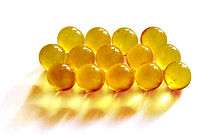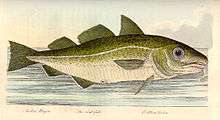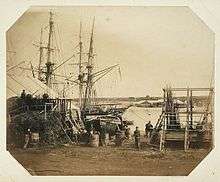Cod liver oil
Cod liver oil is a dietary supplement derived from liver of cod fish (Gadidae).[1] As with most fish oils, it contains the omega-3 fatty acids eicosapentaenoic acid (EPA) and docosahexaenoic acid (DHA). Cod liver oil also contains vitamin A and vitamin D. Historically, it was given to children because vitamin D had been shown to prevent rickets, a consequence of vitamin D deficiency.[2]


Manufacture


Cod liver oil has traditionally come in many grades. Cod liver oil for human consumption is pale and straw colored, with a mild flavor. Scandinavian Vikings produced cod liver oil by laying birch tree branches over a kettle of water, and fresh livers were laid over the branches. The water was brought to a boil and as the steam rose, the oil from the liver dripped into the water and was skimmed off. There was also a method for producing fresh raw cod liver oil.[3]
In the Industrial Revolution, cod liver oil became popular for industrial purposes. Livers placed in barrels to rot, with the oil skimmed off over the season, was the main method for producing this oil. The resulting oil was brown and foul tasting. In the 1800s cod liver oil became popular as a medicine and both pale and brown oils were used. Brown oils were common because they were cheaper to produce. Some doctors believed in only using the fresh pale oil, while others believed the brown oil was better. However the brown oils tended to cause intestinal upset.[3]
The Möller Process was invented by Peter Möller in 1850. The livers are ground with water into a slurry, then this is gently simmered until the oil rises to the top. The oil is skimmed off and purified.[4] Other methods used in modern times include the Cold Flotation Process, pressure extraction, and pressure cooking. These all require further purification steps to get a pure oil.[5]
Therapeutic uses
Though similar in fatty acid composition to other fish oils, cod liver oil has higher concentrations of vitamins A and D. According to the United States Department of Agriculture, a tablespoon (13.6 grams or 14.8 mL) of cod liver oil contains 4,080 μg of retinol (vitamin A) and 34 μg (1360 IU) of vitamin D.[6] The Dietary Reference Intake of vitamin A is 900 μg per day for adult men and 700 μg per day for women, while that for vitamin D is 15 μg per day. The Tolerable upper intake levels (ULs) are 3000 μg/day and 100 μg/day, respectively. People consuming cod liver oil as a source of omega-3 fatty acids should pay attention to how much vitamin A and vitamin D this adds to their diet.[7][8]
Cod liver oil is approximately 20% omega-3 fatty acids.[9] For this reason cod liver oil may be beneficial in secondary prophylaxis after a heart attack.[10] Diets supplemented with cod liver oil have also been demonstrated to have beneficial effects on psoriasis[11] and depression.[12]
Potential adverse effects

A tablespoon (13.6 g) of cod liver oil contains 136% of the UL for preformed vitamin A (retinol).[13][14] Vitamin A accumulates in the liver, and can reach harmful levels sufficient to cause hypervitaminosis A.[7] Pregnant women may want to consider consulting a doctor when taking cod liver oil because of the high amount of retinol.[15]
Fatty acid oxidation and environmental toxins content are reduced when purification processes are applied to produce refined fish oil products.[16]
Other uses
In Newfoundland, cod liver oil was sometimes used as the liquid base for traditional red ochre paint, the coating of choice for use on outbuildings and work buildings associated with the cod fishery.
In Tübingen, Germany, drinking a glass of cod liver oil is the punishment for the loser at the traditional Stocherkahnrennen, a punting boat race by University of Tübingen groups.
See also
References
- "REPORT OF THE TWENTY FORTH SESSION OF THE CODEX COMMITTEE ON FATS AND OILS" (PDF). Report of the Twenty Forth Session of the CODEX Committee on Fats and Oils. JOINT FAO/WHO FOOD STANDARDS PROGRAMME CODEX ALIMENTARIUS COMMISSION. Archived (PDF) from the original on 10 October 2015. Retrieved 8 December 2015.
- Rajakumar, K. "Vitamin D, Cod-Liver Oil, Sunlight, and Rickets: A Historical Perspective. 2003". Pediatrics. 112 (2): 132–135.
- "Extra-Virgin Cod Liver Oil History". Archived from the original on 11 October 2016. Retrieved 14 October 2016.
- "World Class Processing". Archived from the original on 16 October 2016. Retrieved 14 October 2016.
- "The Fish Liver Oil Industry" (PDF). Archived (PDF) from the original on 18 October 2016. Retrieved 14 October 2016.
- "Welcome to the USDA Food Composition Database". ndb.nal.usda.gov. Archived from the original on 15 November 2014. Retrieved 29 April 2018.
- Paul Lips (8 May 2003). "Hypervitaminosis A and fractures". N Engl J Med. 348 (4): 1927–1928. doi:10.1056/NEJMe020167. PMID 12540650.
- Haddad J.G. (30 April 1992). "Vitamin D — Solar Rays, the Milky Way, or Both?". The New England Journal of Medicine. Retrieved 29 January 2012.
- "Fish oil, cod liver". Nutrition Data. Retrieved 19 March 2019.
- von Schacky, C (2000). "n-3 Fatty acids and the prevention of coronary atherosclerosis". Am J Clin Nutr. 71 (1 Suppl): 224S–7S. doi:10.1093/ajcn/71.1.224s. PMID 10617975.
- Wolters, M. (2005). "Diet and psoriasis: experimental data and clinical evidence". British Journal of Dermatology. 153 (4): 706–14. doi:10.1111/j.1365-2133.2005.06781.x. PMID 16181450. S2CID 1426074.
- Raeder MB, Steen VM, Vollset SE, Bjelland I (August 2007). "Associations between cod liver oil use and symptoms of depression: the Hordaland Health Study". J Affect Disord. 101 (1–3): 245–9. doi:10.1016/j.jad.2006.11.006. PMID 17184843.
- National Nutrient Database for Standard Reference "USDA Nutrition Facts: Fish oil, cod liver" USDA
- Jane Higdon, Ph.D. of the Linus Pauling Institute "Linus Pauling Institute Micronutirent Center" Archived 17 January 2012 at the Wayback Machine Oregon State University
- Myhre AM, Carlsen MH, Bøhn SK, Wold HL, Laake P, Blomhoff R (December 2003). "Water-miscible, emulsified, and solid forms of retinol supplements are more toxic than oil-based preparations". Am. J. Clin. Nutr. 78 (6): 1152–9. doi:10.1093/ajcn/78.6.1152. PMID 14668278.
- Bays H E (19 March 2007). "Safety Considerations with Omega-3 Fatty Acid Therapy". The American Journal of Cardiology. 99 (6 (Supplement 1)): S35–S43. doi:10.1016/j.amjcard.2006.11.020. PMID 17368277.
External links
| Wikimedia Commons has media related to Cod liver oil. |
